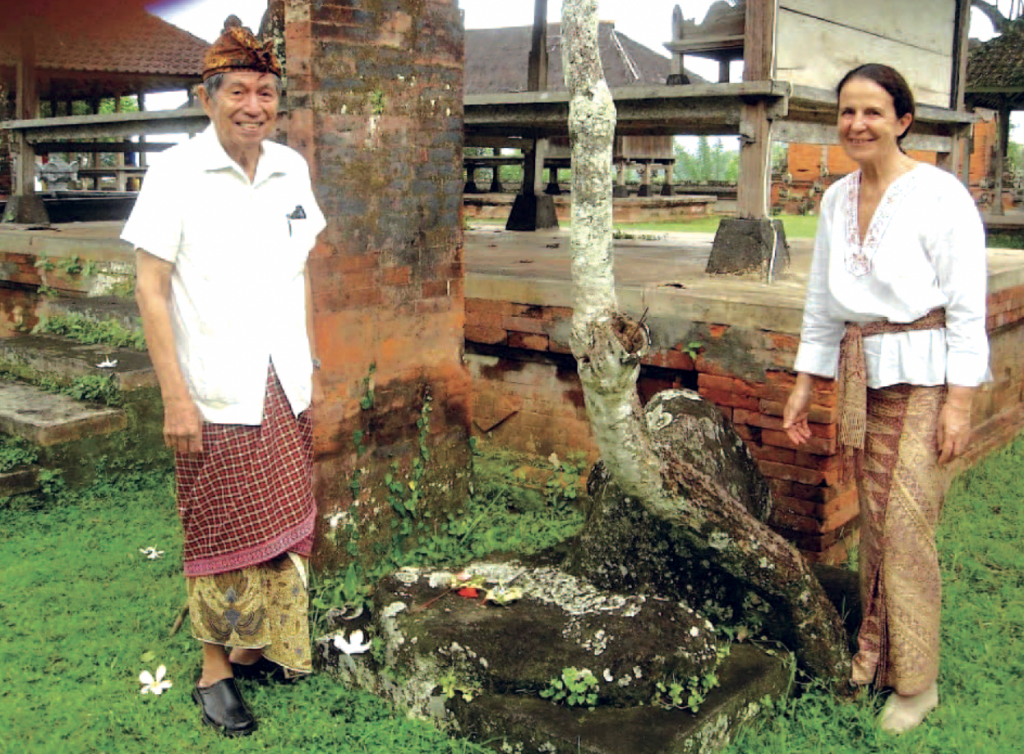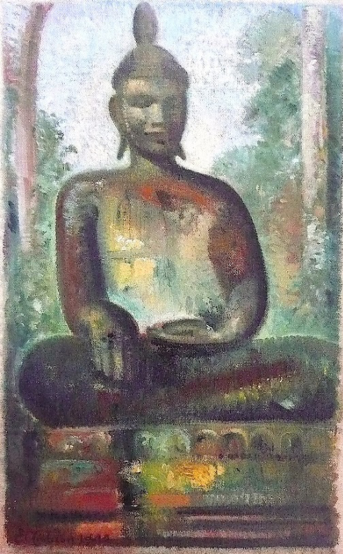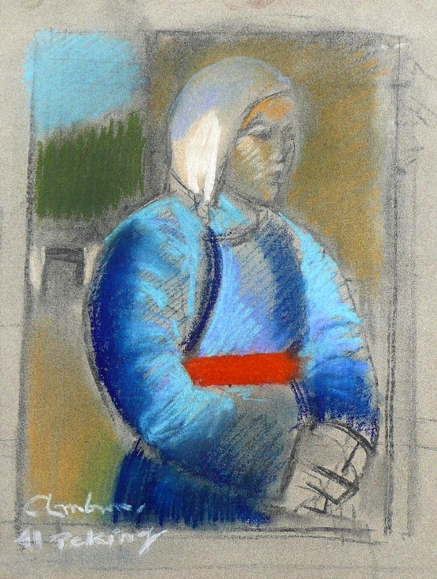IO – Idanna Pucci has described Florence as a hermetic city, with layers of culture and history and, in her view, Bali is very similar. “I have interacted with Bali for thirty- eight years, and I must say that there is still so much hidden under the surface which I will never know.”
She describes how when she first arrived in Bali the foreigners she met had by and large chosen to live on the island because of its culture: anthropologists, writers, musicians, dancers, painters, and historians. There were no shippers at the time because business entrepreneurs had not yet discovered the island.
“I settled in Bali,” Idanna says, “because, as a student of comparative literature, my interest was the transmission of knowledge, not through books, but by word of mouth, from one generation to the next. What is known as the oral tradition. Living in Bali meant being exposed constantly to some form of learning.

Much of it might even be through “passive activity” in the sense that I could sit on a veranda and look out on any landscape for hours, and always something new or changing would happen around me. At the end I would feel exhausted… as if I had worked not only with my mind but also physically. This kind of opportunity to learn is quite rare in my part of the world.”
She remembers particularly two people who were important in her understanding of Balinese culture. They were completely different from each other: one was the late I Gusti Gde Raka of Saba, a gentleman of great culture with a sense of history, a philosopher and a shadow-play puppeteer as well as a talented masked dancer; the other person was I Nyoman Dadi, a simple illiterate farmer, who had no land of his own. He was very poor but a born storyteller and knew every inch of the fields around his village of Iseh. He had been courageous and daring during World War II against the Japanese and also during the terrible Gunung Agung eruption of 1963. His claim to fame was that he had been the caretaker of the studio in Iseh of the legendary German-Russian artist, Walter Spies, a mythical figure in the history of foreign residents in Bali before the Japanese occupation. Idanna found both personalities so fascinating and exemplary that she recorded their views and stories which she was able to do thanks to a grant from the Margaret Mead Institute of Intercultural Studies for a project called, The Prince and the Pauper: Two Balinese Portraits.
However, Idanna considers her true mentor Dr. A.A. Made Djelantik, the extraordinary protagonist of her recent book, The World Odyssey of a Balinese Prince, a collection of his life stories and evocative illustrations.
She stresses that both Italian and Balinese cultures have centuries of history and layers of vibrant culture. Renaissance Florence of the 15th century and its magnificent heritage of literature, architecture, and fine arts could not have happened without its tradition of artisans that is still alive today in spite of globalization and the pressure of modernity.

“This makes me think of Bali’s ancient royal dynasty of Klungkung,” Idanna says, “direct descendant of Majapahit, the great Hindu kingdom of East Java, and this is why all the kings of Bali looked up to the leadership of the Dewa Agung of Klungkung as the highest of all. Klungkung’s Renaissance was born four centuries ago from the ancestors of today’s great artists and artisans who continue to thrive in the 21st century, contributing greatly to Bali’s current wealth.”
The wayang style of painting, known as Kamasan from the village where the painters reside, near Klungkung, is widely celebrated, and examples of Kamasan masterpieces can be found in museums around the world. Communities of silversmiths still create the ornate silver offering trays and the essential ritual objects used by the high priests to officiate ceremonies in Bali. Klungkung is also known for its woven textiles, from the Sidemen ikat style to the ceremonial songket with its gold and silver threads.
Bali is the homeland of brilliant woodcarvers, basket weavers, mask makers, contemporary painters, stone carvers, goldsmiths, and more recently also passionate potters. Idanna muses that “Tuscany and Bali are very similar when it comes to people’s dexterity with handcrafted arts. What created Florence’s wealth in the Middle Ages the ability to soften coarse sheep wool, and later in the Renaissance the secret of dyeing silks into colors never seen before, and weaving fabrics into splendid brocades.”

Both Bali and Tuscany are major tourist destinations and share in common all the drawbacks of tourism. Idanna had all this in mind when she first voiced the idea that there were many reasons for Florence and Klungkung to become sister cities. It happened when the Tuscan artist Emilio Ambron confessed that his dream was to find a way to donate a large collection of his artworks to Bali. He was nearing the wise age of 90 that made him extremely anxious about the fate of his art. Most of his drawings, paintings and sculptures had been influenced by his time in Asia, in Cambodia and China, but the years spent in Bali had the greatest impact of all.
Emilio Ambron was born on November 17th, 1905 in Alexandria, Egypt, where his father managed the concession of the port of Alexandria, and was also the architect to King Farouk. At that time, there was a large Italian community in Alexandria, and the Ambrons were among the most refined and intellectual families in the city. Emilio’s mother, Amelia Ambron, was a famed portrait painter, and his sister Gilda a talented musician. To please his father, Ambron graduated in law from university, but he was truly an artist at heart. Finally, his father, having such an artistic family, decided to purchase a 600 hectare estate near Siena in Tuscany, and give the chance to his wife and children to spend some months every year in close contact with the mythical cities of art, Florence and Siena. Later, after the war, the family left Egypt and settled in Rome. But Emilio soon bought a large studio in Florence, and moved there.

Idanna first met Ambron as a teenager. By then, Emilio had inherited his father’s fortune. Aside from his parents, he had also lost his beloved sister in a plane crash. In his villa near Siena, his works of art were scattered everywhere, making it seem like a huge studio that extended even outside to the large gardens where his marble sculptures were harmoniously placed among the cypress trees and the wisteria.
“I met Ambron again with my stepfather, Antonio Piccolomini, when I returned from Bali in the seventies.” My stepfather’s family was historically very noted in Siena thanks to Pope Pious II, who was a direct ancestor. Ambron’s estate had been a Piccolomini property, and the families had remained friends.

But how did Emilio Ambron come all the way to Bali in 1938? The drums of war had already been pounding in Europe but, even if Italy did not enter the war on the side of Germany until two years later, Ambron, felt he had to leave and go faraway. As an artist, he lived in his own world, far from the intrigues of politics and the coming nightmare facing Europe.
On a visit to Paris with his sister, he was struck by an “illumination”. Walking along a boulevard, his eyes fell on a film poster with a large outrigger boat in a background of palm trees. He could not resist and he stepped into the cinema. There, he found himself in Bali, mesmerized by the beauty and life of the island. The documentary virtually transported him to the other side of the world. As the days passed, other signs came his way, all having to do with Indonesia and Bali. He felt he could not ignore them, and Gilda agreed.
So, in Paris, they booked passage on the next ship sailing from Marseille to Batavia, then the capital of the Dutch East Indies. From Batavia, now Jakarta, he voyaged to Singaraja in north Bali, and then motored all the way to Denpasar. The rest is history. In Bali, he stayed four years, from 1938 to 1942, until the Japanese occupation. That is when his adored sister left to join her parents still in Egypt, but sadly never arrived because her plane crashed en route.

As the Japanese began invading the Netherlands Indies in 1942 he left Bali with the Italian painter Romualdo Locatelli. They sailed to the Philippines but, in Manila, his wonderful friend Romualdo disappeared mysteriously, never to be seen again. Now, alone and grieving, Ambron sailed on to Bejing, and from there to Hanoi and then Vientiane in Laos. Finally, he settled for three years in Siem Reap, near the great Khmer temples of Angkor Vat in Cambodia. When the war ended, he returned to Alexandria and then finally settled in Florence, where he spent the rest of his life.
Idanna’s father as well as her uncle, fashion designer Emilio Pucci, also knew Ambron. When her uncle first went to Indonesia in 1960, he carried a letter of introduction from Ambron to the Italian Ambassador Muzi Falconi, who gave him a very special welcome. Over the years, when Idanna returned to Florence, she would always visit Ambron who became part of both her Balinese and Florentine lives, despite their age difference.

His studio in Florence was a Balinese oasis in the heart of the city. Ambron’s style is classical, similar to the Renaissance masters. He was a maestro in drawing the body in movement, as if he too was dancing with his brush and pencil, following the rhythm of the dancers of Bali. He would recount to Idanna various stories about all the artists, local and foreign, he had met on the island, and with whom he had shared important moments in those crucial years. One of the artists he mentioned was Arthur Fleischman, a sculptor from Bratislava, Slovakia, who ended up settling in the United Kingdom. He too was forever inspired by Bali. Names such as Hofker, Bonnet, Le Majeur, Neka were always part of the conversation. Arie Smit, whom Ambron met during one of his trips back to Bali, became a frequent guest in Cotorniano, the Ambron estate near Siena.
It is not surprising then if Ambron, towards the end of his life, expressed his profound wish to donate to Bali a collection of his most cherished artworks, and more precisely to Klungkung, the ancient royal capital of the island. And so Idanna presented an official and detailed proposal to the City Council of Florence. She outlined all the shared aspects which Klungkung and Florence had in common and she managed to overcome the infamous Italian bureaucratic procedures. On June 14, 1996, the Sister City Pact was approved – just nine days after Ambron took his final breath.

Meanwhile, the city of Klungkung – now renamed Semarapura – had accepted the honor and responsibility of the valuable donation and had reserved two large halls in the city museum on the grounds of the former royal palace. Garuda Indonesia generously offered the transportation – seven tons of paintings, drawings, and sculptures in bronze and marble, a total of 68 artworks – from Florence to Ngurah Rai Airport in Denpasar. On July 27, Idanna and her husband, Terence Ward, boarded the same plane in Rome and accompanied the precious cargo to its final destination. Idanna’s close Italian friends and old-time residents of Bali collaborated in the installation of the collection: the late fashion designer Milo and his brother Ezio; the talented furniture designer, Carlo Pessina; and Rodolfo Giusti of Lotus Entreprises. I Made Nasib from Ketewel, Gianyar, made the frames and executed the installation with his team of assistants. In those heady days, two very powerful Indonesian personalities tried to appropriate the collection, but thankfully the gods did not allow it, and the works stayed in their promised new home, where they are guarded vigilantly. Ambron’s art remains “a missing link” in many private art collections in Indonesia.
Today, Ambron’s paintings and sculptures, on display at the Museum Semarajaya of Klungkung, serve as an inspiration for local as well as foreign artists, and continue to surprise visitors who walk in and, are unexpectedly confronted with timeless portraits of beauty rendered by a Florentine hand. (Tamalia Alisjahbana)

If you enjoyed this article you may like to read more about Idanna Pucci by the same writer:
Part I : https://observerid.com/idanna-pucci-an-italian-marchesa-in-bali-part-i-a-new-edition-of-the-world-odyssey-of-a-balinese-prince/
Part II : https://observerid.com/idanna-pucci-from-florence-to-bali-part-ii-lifes-journey/
Part III: https://observerid.com/idanna-pucci-from-florence-to-bali-part-iii-vagando-aquiro/

